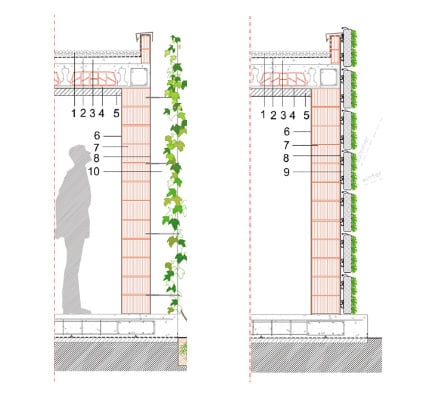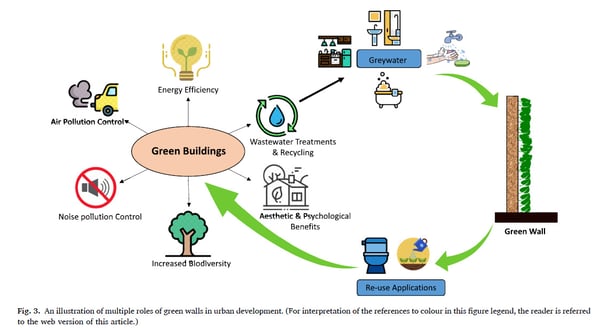Climate change is an increasing concern for our society, which is why interest in nature-based solutions and urban green infrastructure is on the rise in an effort to create more liveable green spaces. Developers, architects, engineers, and city planners see it as a sustainable method to aid in resolving urban problems and restoring green space in cities. The main benefits include reducing the threat of high temperatures and pollution to human health, while also providing beauty, comfort and mental well-being (1).
What are Vertical Green Spaces?
Vertical green spaces (VGS) is an umbrella term for both green facades and green walls. The benefits of traditional green facades - climbers led along the building face, have been well known for ages, perhaps millennia, while green walls represent a contemporary, advanced technological solution with a pre-cultivated modular-based system that grows close to the façade (1).
Green façades employ soil-bound plants, typically woody or herbaceous climbers that grow directly against the building wall (direct green façade) or on a support system (indirect green façade). Green walls, however, involve plant support structures attached to the building wall such as a screen, tray, vessel, planter tiles and flexible bags, and sometimes require some minor maintenance and irrigation. The plants do not root in the ground soil, which considerably increases the application possibilities and allows for a rapid, uniform coverage over a large surface (2).
 The distinction between a green façade and a green wall system. Source: (1) - Chàferet et. al. (2021)
The distinction between a green façade and a green wall system. Source: (1) - Chàferet et. al. (2021)
Vertical green systems contribute to reducing the energy demands of buildings by providing shade and insulation, mitigating the urban heat island and cooling down public spaces. They also provide carbon sequestration, acoustic improvements, reduction in pollution levels and help improve biodiversity. Other less measurable, but apparent benefits include an effect on human health and social and cultural benefits (1).
VGS Fighting Urban Air Pollution
Air pollution caused by particle matter poses a risk to health in urban environments. Currently, as much as 84% of the global population is exposed to airborne particle pollution levels that exceed the WHO guidelines (2). Due to the porous nature of plants, they are ideal in acting towards airborne pollution removal and deposition, as well as influencing local air pollutant dispersion patterns. Plants act as living filters, facilitating air detoxification, particle absorption and accumulation on leaf surfaces. The vertical alignment of green walls follows existing urban surfaces and increases their potential for pollution reduction. That makes them an effective system that requires minimal adjustments to the built environment, making the adoption of this technology both efficient and desirable (3).
Green walls can be an effective greening strategy for capturing particle pollution in urban spaces since they can be applied throughout the enormous available wall area in cities. Importantly, they do not interfere with the prevailing ventilation in street canyon situations, which can be a problem with some other green infrastructure, for example in the form of tree borders of hedges, that can affect air streams. Green walls can also be placed very close to the pollutant source, making them even more efficient - a green wall located next to a busy road captures roughly 1010 to 1011 particles per square meter of leaf area (2).
Green Walls as Constructed Wetlands
Green infrastructure systems, green walls included, are among the most environmentally friendly technologies for cleaning water and air in urban settlements. They have the ability to act as constructed wetlands. Constructed wetlands are vegetation-based water treatment technologies that utilise the purification functions inherent to natural ecosystems to reduce water pollution. As an additional advantage, they offer an aesthetic experience and can be used for enhancing the beauty and biodiversity of the urban environment. However, most have a large land requirement, which is a major drawback. This is why green walls are emerging as an ideal solution. They possess the ability to perform the functions of constructed wetlands in wastewater treatment without occupying copious amounts of space. Due to their vertical structure, they can easily be implemented almost throughout the city environment. The implementation of green walls in such a way, therefore, offers a sustainable solution to wastewater treatment and recycling in modern architecture (4).

An illustration of multiple roles of green walls in urban development. Source: (4) - Addo-Bankas et. al. (2021)
Green walls remove pollutants in wastewater through physical (via straining and sedimentation; filtration), chemical (via reaction, adsorption) as well as biological (via microbial assimilation in plant and biofilm in the substrate) and other microbial processes. This is done while water naturally drains vertically down through the substrate. The vegetation also provides a habitat for microorganisms that take up nutrients and degrade organic pollutants from the wastewater. They can be employed in greywater treatment in order to reduce environmental stress and some studies have already shown them to effectively treat wastewater for further reuse. The vertical design makes them ideal for wastewater treatment and water recovery for urban settlements with limited space (4).
Green walls as Low Impact Development
Low impact developments (LIDs) are becoming more and more important as a part of urban developments, providing a sustainable option for urban environments. Green infrastructure including green walls and green roofs are proving to be desirable architectural elements, effective in harnessing the sustainable benefits and compensating some environmental benefits lost through urban development. Compared to green roofs, green walls are sometimes even more environmentally advantageous since they offer more area for vegetative cover in high rising buildings. Therefore, researchers and designers alike agree that green walls are a viable and highly desirable design option in urban infrastructure in years to come due to their numerous environmentally friendly benefits compared to conventional infrastructure (4).
Author: Ana Belčič, Studio MIAO
|
Don’t forget to us during our “Living with a green heart” weeks (between 16– 22.1.2022 and 30.1–5.2.2022) when a group of like-minded companies will (including Urbanscape® Green Solutions Team, together with the visitors, explore how sustainable solutions and social sustainability actions (especially those focused on people’s well-being) can lead to a better world for all of us. Register here: https://green-heart.si/en/invite/ |
Sources:
(1) Marta Chàfer, Gabriel Pérez, Julià Coma, Luisa F. Cabeza (2021). A comparative life cycle assessment between green walls and green facades in the Mediterranean continental climate, Energy & Buildings 249
(2) Tess Ysebaert, Kyra Koch, Roeland Samson, Siegfried Denys (2021). Green walls for mitigating urban particulate matter pollution—A review, Urban Forestry & Urban Greening 59
(3) Naomi J. Paull, Daniel Krix, Peter J. Irga, Fraser R. Torpy ()
(4) Olivia Addo-Bankas, Yaqian Zhao, Jan Vymazal, Yujie Yuan, Jingmiao Fu, Ting Wei (2021). Green walls as form of constructed wetland, Ecological Engineering 169


